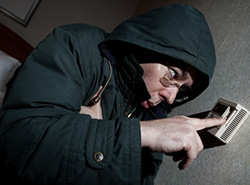
This frigid Vermont winter may have some people rethinking their method of heating. There are numerous methods of heating available to both commercial and residential property owners, all of which are better suited to some applications than to others. One lesser-known heating method is radiant heating.
What is Radiant Heating?
The term “radiant heating” refers to a method of warming spaces using radiant energy, rather than more conventional means. If you’ve felt warm sunshine, you’ve experienced radiant energy. Radiant heaters warm objects and people in just the same way that the sun’s short-wavelength energy heats the ground, the oceans and our skins.
Essentially, heat energy emitters can be located in any architectural design element, including under floors, in walls, or in a device, such as a radiant, ceiling-mounted heating panel. Methods of radiant heating do not include the use of conventional radiators (they work primarily by convection).
Efficiency Benefits
Occupants and objects are heated directly by the radiant energy, rather than experiencing warmth that has first been transferred to the air. This can result in conspicuous energy savings. People experience the same degree of perceived body comfort they expect from conventional heating methods, but at a much reduced ambient temperature, so less fuel is used.
Another advantage is of particular benefit in some commercial applications, and in residential applications where occupants are prone to allergic reactions, suffer from asthma or have pulmonary ailments and infections. Because heat is not transferred to air — which must then be maneuvered into the work or living space — radiant heat installations create almost no air movement. When compared to a conventional forced air heating system, for instance, which employs an air mover and a network of ducts, airborne particle movement is markedly reduced.
Process of Installation
Retrofitting radiant heating devices to preexisting buildings or exterior areas can be a complex process, determined largely by original construction techniques. Each conversion is likely to be unique.
Electric systems are the simplest to install. Creating heat with electricity is, however, a comparatively expensive process. That said, heat is simply a transfer of energy which we perceive physically. Increasing the surface area of the heat source increases thermal transfer efficiency, so larger areas — walls, floors — heat up their targets more swiftly. This uses less energy, which translates into increased efficiency. All supply energy is returned as perceivable heat (none is lost to exhaust gases, for instance, or consumed by support devices such as fans).
Installation Options
Underfloor and in-wall systems are known in industry-speak as “low-temperature systems;” large emission surfaces deliver the same heat transfer from much lower temperature heat sources. Overhead-mounted panels are less efficient. Their surface temperatures must be much higher to impart the same sense of perceived warmth.
That said, in several commercial and domestic applications, conventional heating is so impracticable as to be impossible. When air is in constant motion around the occupants of a space, the use of forced air and radiator-based installations is impossible; heat is dissipated before reaching the target. Even with little or no air movement, vaulted spaces waste heat. This makes overhead radiant panels particularly useful for:
- Open production spaces
- Warehouses
- Sports facilities
Radiant heat is also a reasonably efficient method of supplying heat to confined, targeted outdoor areas. Locations that might benefit include:
- Outdoor markets
- Restaurant patios
- Residential decks used throughout cold seasons




